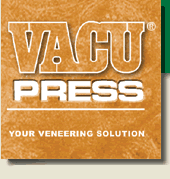| | |
Peter Ness

|
Paper back veneer is very thin, usually thinner than "raw" veneer flitches (which are just the wood). The very thin wood face is preglued to a paper backing - you glue the paper backing down on your wood.Paper back veneer is usually available in the more common woods and comes in standard sheet sizes 2x8, 4 x 8 etc. Because it is made from veneer flitches bonded to a paper backing, the sheet size is made up of pieces matched at the factory - be aware that someone else is matching up the pieces, ie. oak may not matter but I have seen the worst walnut burl matchup ever on paperback.The drawbacks of paperback is that the wood layer is so thin you practically have nothing to sand, more so than "raw" veneer flitches. If you use any heavy finish, the wood veneer can separate from the paper backing - here as well as between the substrate and paper back.So why is it made? - it is easy to do and you can glue it down with contact cement. Also you dont have to tape up larger sheets from smaller flitches. I can tell you from expensive personal experience it often delaminates or bubbles.If you bought the videos and are going to get a vacuum press, you could use the paperback veneer, just remember that it is very thin when finishing (sand extremely little and use finish sparingly - forget about staining it - everytime I tried it delaminated, but I was using contact cement without a press.)I wouldn't recommend using it especially if you are doing smaller items or are doing flat work - there is more variety and choice with flitches than with the paperback. Flitches are also cheaper and have nicer faces (esp. burls).Hope this helps
|
|





